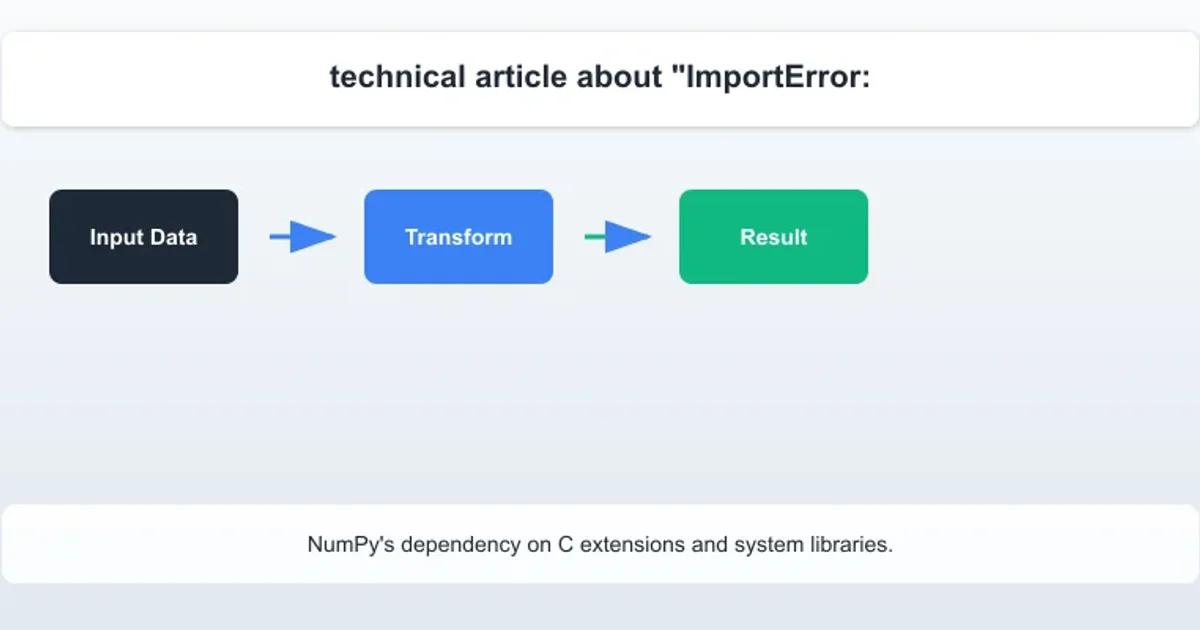ImportError: numpy.core.multiarray failed to import
Categories:
Resolving 'ImportError: numpy.core.multiarray failed to import' in Python

This article provides comprehensive solutions and troubleshooting steps for the common 'ImportError: numpy.core.multiarray failed to import' error, frequently encountered when working with NumPy and OpenCV in Python environments.
The ImportError: numpy.core.multiarray failed to import is a frustratingly common error that can halt your Python projects, especially when dealing with libraries like NumPy and OpenCV. This error typically indicates an incompatibility or corruption within your NumPy installation, often stemming from mismatched versions, broken dependencies, or issues with the underlying C extensions that NumPy relies on. Understanding the root causes and systematic troubleshooting steps is crucial for resolving this issue efficiently. This guide will walk you through various scenarios and provide practical solutions to get your environment back on track.
Understanding the Root Cause
NumPy, a fundamental package for scientific computing in Python, relies heavily on compiled C extensions for performance. The multiarray module is one such critical component, responsible for handling N-dimensional arrays. When Python attempts to load NumPy, it tries to import these compiled extensions. If there's a mismatch between the Python interpreter, the NumPy version, or its compiled components (e.g., due to different compilers, conflicting libraries, or an incomplete installation), this ImportError occurs. This is particularly prevalent in environments with multiple Python versions, virtual environments, or when upgrading/downgrading packages.
flowchart TD
A[Start Python Script] --> B{Import numpy}
B --> C{Load numpy.core.multiarray}
C -- Failed --> D[ImportError: numpy.core.multiarray failed to import]
C -- Success --> E[NumPy Loaded Successfully]
D --> F{Troubleshooting Steps}
F --> G[Check Python/NumPy Versions]
F --> H[Reinstall NumPy]
F --> I[Check Virtual Environment]
F --> J[Update pip/setuptools]
F --> K[Check for Conflicting Packages]
G --> B
H --> B
I --> B
J --> B
K --> BFlowchart illustrating the import process and potential failure point for numpy.core.multiarray.
Common Scenarios and Solutions
This error often arises from a few common scenarios. Addressing these systematically can help pinpoint and resolve the problem. Always try the simplest solutions first before moving to more drastic measures like full environment reinstallation.
1. Step 1: Reinstall NumPy
The most common fix is to simply reinstall NumPy. This ensures that all its compiled components are correctly linked to your current Python environment. Use pip to uninstall and then reinstall.
2. Step 2: Upgrade pip and setuptools
Outdated versions of pip or setuptools can sometimes cause issues with package installations, especially with binary wheels. Upgrading them can resolve underlying dependency problems.
3. Step 3: Check Python and NumPy Version Compatibility
Ensure that your NumPy version is compatible with your Python version. Older Python 2.7 environments might require specific NumPy versions. For Python 3.x, ensure you're not mixing Python 2 and Python 3 packages.
4. Step 4: Verify Virtual Environment Isolation
If you're using a virtual environment, ensure that packages are installed within it and not globally. Sometimes, global packages can interfere with virtual environment installations. Recreating the virtual environment can also help.
5. Step 5: Check for Conflicting Packages (e.g., OpenCV)
Libraries like OpenCV (specifically opencv-python) often come bundled with their own NumPy dependencies. If you have multiple versions of NumPy or conflicting installations, this can lead to the multiarray error. Try reinstalling OpenCV after NumPy.
Practical Solutions and Code Examples
Here are the specific commands and approaches to implement the solutions discussed above.
pip uninstall numpy
pip install numpy
Reinstalling NumPy to fix potential corruption or incompatibility.
python -m pip install --upgrade pip setuptools
Upgrading pip and setuptools to their latest versions.
# Check Python version
python --version
# Check NumPy version (if installed)
pip show numpy
# If using Python 2.7, you might need an older NumPy version, e.g.:
pip install numpy==1.16.6
Commands to check Python and NumPy versions and install a specific NumPy version for Python 2.7.
# Create a new virtual environment
python -m venv myenv
source myenv/bin/activate # On Windows: myenv\Scripts\activate
# Install packages within the new environment
pip install numpy opencv-python
Creating and activating a new virtual environment, then installing necessary packages.
pip uninstall opencv-python
pip install opencv-python
Reinstalling OpenCV after ensuring NumPy is correctly installed.
sudo pip or installing packages globally, as this can lead to permission issues and conflicts between system-wide and user-specific Python installations. Always prefer virtual environments.Advanced Troubleshooting
If the basic solutions don't work, you might be facing a more complex issue related to your system's C/C++ compilers or library paths. This is less common but can occur in specific environments.
One advanced scenario involves issues with the underlying C runtime libraries. NumPy's multiarray module is a compiled C extension. If your system's C runtime libraries are corrupted or incompatible, this can manifest as an ImportError. This is particularly relevant on Windows where Visual C++ Redistributable packages are crucial. Ensuring these are up-to-date can sometimes resolve the issue.

NumPy's dependency on C extensions and system libraries.